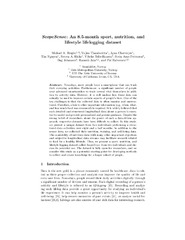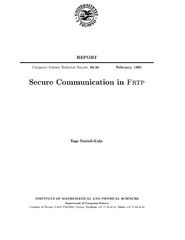Blar i tittel Artikler, rapporter og annet (informatikk)
Viser treff 295-314 av 389
-
Safe Learning for Control using Control Lyapunov Functions and Control Barrier Functions: A Review
(Journal article; Tidsskriftartikkel; Peer reviewed, 2021-10-01)Real-world autonomous systems are often controlled using conventional model-based control methods. But if accurate models of a system are not available, these methods may be unsuitable. For many safety-critical systems, such as robotic systems, a model of the system and a control strategy may be learned using data. When applying learning to safety-critical systems, guaranteeing safety during learning ... -
Satellite communication applied in a distributed application
(Research report; Forskningsrapport, 1994-12)The paper describes the development of a prototype application for access to vital weather information from the Northern Atlantic sea region. The application gives meteorologists access to weather observations measured on sea vessels. Today the available information is very limited. On a daily basis, only 4-5 weather observations in the whole arctic sea-region are conducted. It is therefore suggested ... -
Scalability of Distributed Version Control Systems
(Journal article; Tidsskriftartikkel, 2017-11-26)<p>Distributed version control systems are popular for storing source code, but they are notoriously ill suited for storing large binary files. <p>We report on the results from a set of experiments designed to characterize the behavior of some widely used distributed version control systems with respect to scaling. The experiments measured commit times and repository sizes when storing single files ... -
ScopeSense: An 8.5-Month Sport, Nutrition, and Lifestyle Lifelogging Dataset
(Chapter; Bokkapittel, 2023-03-29)Nowadays, most people have a smartphone that can track their everyday activities. Furthermore, a significant number of people wear advanced smartwatches to track several vital biomarkers in addition to activity data. However, it is still unclear how these data can actually be used to improve certain aspects of people’s lives. One of the key challenges is that the collected data is often massive and ... -
Search-based composition, streaming and playback of video archive content
(Journal article; Tidsskriftartikkel; Peer reviewed, 2011)Locating content in existing video archives is both a time and bandwidth consuming process since users might have to download and manually watch large portions of superfluous videos. In this paper, we present two novel prototypes using an Internet based video composition and streaming system with a keyword-based search interface that collects, converts, analyses, indexes, and ranks video content. ... -
Secure and scalable statistical computation of questionnaire data in R
(Journal article; Tidsskriftartikkel; Peer reviewed, 2016-08-12)Collecting data via a questionnaire and analyzing them while preserving respondents' privacy may increase the number of respondents and the truthfulness of their responses. It may also reduce the systematic differences between respondents and non-respondents. In this paper, we propose a privacy- preserving method for collecting and analyzing survey responses using secure multi-party computation. The ... -
Secure communication in FRTP
(Research report; Forskningsrapport, 1995-02)To ensure privacy, users of the File Repository Transfer Protocol (Frtp) may require that communication partners are properly authenticated. If one partner wants the communication to be crypted, the other must honor the request. This report describes how authentication and privacy are realized. It is shown, by means of an authentication logic, that the protocol achives its goal in this respect. -
Secure Distributed Storage in Peer to Peer Networks
(Lecture; Forelesning; Peer reviewed, 2008-02-07) -
Security in the PASTA project
(Research report; Forskningsrapport, 1997-02-04)This paper presents the system model for the work on security in the Pasta project. We present the objectives of the security effort, the threats we will consider, and those we will not consider. As such, the paper describes the environment which applications must be prepared to face, and still provide users with the desired degree of privacy. -
Selection of Response Reduction Factor Considering Resilience Aspect
(Journal article; Tidsskriftartikkel; Peer reviewed, 2023-02-27)The selection of an adequate response reduction factor (R) in the seismic design of a reinforced concrete building is critical to the building’s seismic response. To construct a robust structure, the R factor should be chosen based on the building’s resilience performance. Since no background was provided for the selection of R factors, the study focuses on the right selection of R factors in relation ... -
A Self-Configuration and Healing Controller To Analyze Misconfigurations of Clusters and IoT Edge Devices
(Conference object; Konferansebidrag, 2023) -
A Self-Configuration Controller To Detect, Identify, and Recover Misconfiguration At IoT Edge Devices and Containerized Cluster System
(Journal article; Tidsskriftartikkel; Peer reviewed, 2023)Securing workloads and information flow against misconfiguration in container-based clusters and edge medical devices is an important part of overall system security. This paper presented a controller that analyzes the misconfiguration, maps the observation to its hidden misconfiguration type, and selects the optimal recovery policy to maximize the performance of defined metrics. In the future, we ... -
Semi-CNN architecture for effective spatio-temporal Learning in action recognition
(Journal article; Tidsskriftartikkel; Peer reviewed, 2020-01-12)This paper introduces a fusion convolutional architecture for efficient learning of spatio-temporal features in video action recognition. Unlike 2D convolutional neural networks (CNNs), 3D CNNs can be applied directly on consecutive frames to extract spatio-temporal features. The aim of this work is to fuse the convolution layers from 2D and 3D CNNs to allow temporal encoding with fewer parameters ... -
Separating mobility from mobile agents
(Research report; Forskningsrapport, 2001-01-16)In this paper we argue that the traditional model of a mobile agent provides a poor programming structure. We base our argument on our experience since 1993 in building distributed applications and mobile agent platforms. We have observed that every distributed applications contain three distinct aspects, which we call function, mobility and management. Separating an application into these three ... -
Shrinkage estimation of rate statistics
(Journal article; Tidsskriftartikkel; Peer reviewed, 2018-10-08)This paper presents a simple shrinkage estimator of rates based on Bayesian methods. Our focus is on crime rates as a motivating example. The estimator shrinks each town’s observed crime rate toward the country-wide average crime rate according to town size. By realistic simulations we confirm that the proposed estimator outperforms the maximum likelihood estimator in terms of global risk. We also ... -
Single image dehazing for a variety of haze scenarios using back projected pyramid network
(Conference object; Konferansebidrag, 2020)Learning to dehaze single hazy images, especially using a small training dataset is quite challenging. We propose a novel generative adversarial network architecture for this problem, namely back projected pyramid network (BPPNet), that gives good performance for a variety of challenging haze conditions, including dense haze and inhomogeneous haze. Our architecture incorporates learning of multiple ... -
Sixteen years of ICPC use in Norwegian primary care : looking through the facts
(Journal article; Tidsskriftartikkel; Peer reviewed, 2010) -
Sleep Monitoring with Wearable Sensor Data in an eCoach Recommendation System: A Conceptual Study with Machine Learning Approach
(Chapter; Bokkapittel, 2023-04-25)The collective effects of sleep loss and sleep disorders are correlated with many adverse health consequences, including increased risk of high blood pressure, obesity, diabetes, depressive state, and cardiovascular symptoms. Research in eHealth can provide methods to enrich personal health care with information and communication technologies (ICTs). An eCoach system may allow people to manage a ... -
Smart contract formation enabling energy-as-a-service in a virtual power plant
(Journal article; Tidsskriftartikkel; Peer reviewed, 2021-10-22)Energy as a service (EaaS) is an emerging business model that enables the otherwise passive energy consumers to play an active role and participate in the energy utility services. This platform is formed through smart contracts registering peer-to-peer (P2P) transactions of energy through price and quantity. Many industries, including finance, have already leveraged smart contracts to introduce ... -
Smart contract formation enabling energy-as-a-service in a virtual power plant
(Journal article; Tidsskriftartikkel; Peer reviewed, 2021-10-22)Energy as a service (EaaS) is an emerging business model that enables the otherwise passive energy consumers to play an active role and participate in the energy utility services. This platform is formed through smart contracts registering peer-to-peer (P2P) transactions of energy through price and quantity. Many industries, including finance, have already leveraged smart contracts to introduce ...


 English
English norsk
norsk


















